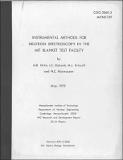| dc.contributor.author | Ortiz, Nestor Ruben | en_US |
| dc.contributor.author | Rickard, I. C. Massachusetts Institute of Technology | en_US |
| dc.contributor.author | Driscoll, Michael J. | en_US |
| dc.contributor.author | Rasmussen, Norman C. | en_US |
| dc.contributor.other | Massachusetts Institute of Technology. Department of Nuclear Engineering | en_US |
| dc.contributor.other | United States. Department of Energy | en_US |
| dc.contributor.other | U.S. Atomic Energy Commission | en_US |
| dc.date.accessioned | 2014-09-16T23:32:10Z | |
| dc.date.available | 2014-09-16T23:32:10Z | |
| dc.date.issued | 1972 | en_US |
| dc.identifier.uri | http://hdl.handle.net/1721.1/89707 | |
| dc.description | "May, 1972." | en_US |
| dc.description | Also issued as an Sc. D. thesis by the first author and supervised by the third and fourth author, MIT Dept. of Nuclear Engineering, 1972 | en_US |
| dc.description | Includes bibliographical references (pages 223-225) | en_US |
| dc.description.abstract | U.S. Atomic Energy Commission contract | en_US |
| dc.description.abstract | The energy spectrum of the neutron flux in a realistic mockup of the blanket region of a large liquid-metal-cooled fast breeder reactor was measured using three different spectrometers: He-3 and Li-6 semiconductor detectors and a Proton-Recoil proportional counter. The He-3 detector was operated in the sum and difference modes, and the Li-6 detector in the sum, difference and triton modes. The experimental data was unfolded using direct, integral and derivative techniques. Methods were developed or perfected to enable use of the He-3 detector over the neutron energy range from 10 keV to 1.3 MeV and the Li-6 detector from 10 keV to 3.1 MeV; the Proton-Recoil detector was operated in the region from 2 keV to 1.5 MeV. In general, good agreement was found between the experimental measurements for all detector types, modes of operation and methods of unfolding, except for the low-energy He-3 data. The present experimental results and previously reported data obtained using a method based on gamma line broadening are in relatively good agreement in the high energy region above 0.8 MeV. The measured neutron spectrum is also similar in shape to neutron spectra measured at ANL in critical assembly mockups of large LMFBR cores, but systematically softer, as expected.. However, there is a large discrepancy in the energy region from 10 keV to 50 keV between the present results and either spectra unfolded from foil data or those numerically calculated using the 1-D ANISN code in the S8 option with 26 energy groups. | en_US |
| dc.format.extent | 225 pages | en_US |
| dc.publisher | Cambridge, Mass. : Massachusetts Institute of Technology, Dept. of Nuclear Engineering, [1972] | en_US |
| dc.relation.ispartofseries | MITNE ; no. 129 | en_US |
| dc.relation.ispartofseries | COO (Series) ; 3060-3 | en_US |
| dc.relation.ispartofseries | AEC research and development report | en_US |
| dc.subject.lcc | TK9008.M41 N96 no.129 | en_US |
| dc.subject.lcsh | Liquid metal fast breeder reactors | en_US |
| dc.subject.lcsh | Liquid metal cooled reactors | en_US |
| dc.subject.lcsh | Neutron flux | en_US |
| dc.title | Instrumental methods for neutron spectroscopy in the MIT blanket test facility | en_US |
| dc.type | Technical Report | en_US |
| dc.identifier.oclc | 856653117 | en_US |
